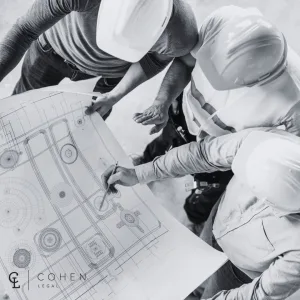Understanding Retaining Walls in Queensland
Retaining walls are more than just garden features — they’re engineered structures built to hold back soil and stabilise land. In North Queensland, where heavy rain and sloping blocks are common, they’re essential for preventing erosion and supporting building foundations.
But when retaining walls fail, crack, or interfere with neighbouring land, the question of who’s responsible can quickly turn into a legal dispute.
Under Queensland’s Building Act 1975 and local council regulations, retaining walls are considered structural works. This means they must be built to engineering standards and, in most cases, approved by a building certifier. Problems often arise when these standards aren’t met, or when property owners assume responsibility lies equally between neighbours.
As Sam Cohen, Principal Lawyer, explains:
“Retaining walls sit right on the boundary between engineering and property law. The disputes that follow are rarely simple — they usually involve both legal and technical questions.”
Whether you’re a homeowner in Townsville or a builder in Mount Isa, understanding your legal position early can make all the difference.
Who Is Responsible for Retaining Walls Between Properties?
Determining who owns or must maintain a retaining wall depends on one key factor — who benefits from it.
Generally, if a retaining wall supports soil that has been filled or excavated by one landowner, that landowner is responsible for its construction and maintenance. For example, if your neighbour excavates their land to create a flat pad for a new home, they are typically responsible for the wall that holds back the soil on your side.

It’s a common misconception that the cost or upkeep of a retaining wall is split “50/50,” like a dividing fence. In fact, the Neighbourhood Disputes (Dividing Fences and Trees) Act 2011 specifically excludes retaining walls from the usual fencing cost-sharing rules.
Local councils also have their say. Some require engineered design and approvals for walls over one metre high or where load-bearing structures sit nearby. Neglecting those approvals can lead to liability for damage, even years later.
“Responsibility depends on who changed the natural ground level. That’s often where the dispute starts.” — Sam Cohen, Principal Lawyer
If ownership or responsibility is unclear, a property dispute lawyer can review land surveys, drainage reports, and council records to clarify the situation before it escalates.
When Retaining Wall Issues Become Legal Disputes
Retaining wall conflicts often start small — a crack, a leaning wall, or a complaint about water runoff after heavy rain. But these issues can quickly escalate when property damage, safety risks, or financial loss are involved.
Common triggers for retaining wall disputes include:
- Structural failure or collapse, causing damage to neighbouring property
- Poor drainage, leading to flooding or soil movement
- Encroachment onto a neighbour’s land or boundary disputes
- Unauthorised construction, without council approval or engineering certification

In Queensland, disputes can arise under several laws — including the Building Act, the Neighbourhood Disputes Act, and local planning schemes. If a retaining wall was built by a contractor, there may also be rights under the Queensland Building and Construction Commission (QBCC) for defective building work.
When informal discussions break down, these disputes can progress to the Queensland Civil and Administrative Tribunal (QCAT) or the courts, particularly if there’s significant damage or a question of negligence.
Cohen Legal often assists when one party alleges the other’s construction caused subsidence or damage — a serious issue in North Queensland’s variable soil conditions. These matters frequently require expert engineering evidence, survey data, and careful legal argument to resolve.
How Litigation and Mediation Can Resolve Retaining Wall Disputes
Once a dispute becomes formal, the focus shifts from neighbourly compromise to evidence and legal process.
A typical pathway involves:
- Early legal advice: establishing ownership, liability, and whether the wall complies with approvals.
- Gathering documentation: including engineering reports, photos, soil testing, and drainage assessments.
- Negotiation or mediation: many matters can be resolved through a negotiated settlement or mediation before formal proceedings.
- QCAT or court proceedings: used where damage is significant, insurance claims arise, or an injunction is needed to stop unsafe work.
Sam Cohen says timing is crucial:
“The earlier you involve a lawyer, the better your chances of resolving things before they escalate. Once the wall moves or fails, the costs — both financial and emotional — increase quickly.”

At Cohen Legal, our Civil Litigation team helps clients weigh the cost of legal action against practical outcomes. In many cases, early advice and structured negotiation save time and money — especially when emotions are running high between neighbours.
If litigation does become necessary, our firm prepares clear, evidence-based cases. We work closely with engineers, surveyors, and expert witnesses to present reliable technical findings that stand up in QCAT or court.
When to Seek Legal Advice from Cohen Legal
If a retaining wall dispute is affecting your property or business, it’s important to act early. Even minor cracks or drainage issues can signal a deeper structural or legal problem.
Cohen Legal regularly represents clients across Townsville, Mount Isa, and wider North Queensland in building and construction litigation. Our team has experience in disputes involving engineers, builders, and adjoining landowners — from small residential claims to complex civil litigation.

We understand the local conditions, the council processes, and the emotional toll that neighbour disputes can take. Our approach is strategic but practical — helping you resolve the issue with clarity and confidence.
“At Cohen Legal, we don’t just look at the wall — we look at the whole picture. Our goal is to help clients find the most effective way forward, whether that’s through negotiation or in court.” — Sam Cohen, Principal Lawyer
If you’re facing a retaining wall or property dispute, Cohen Legal can help you understand your rights and take action with confidence. Contact our Townsville or Mount Isa offices for clear, strategic advice.
For more about our expertise, visit our Building and Construction Lawyers page.
Disclaimer
This article provides general information only and does not constitute legal advice. You should obtain advice specific to your circumstances before making any decisions.

